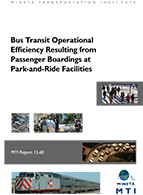- 408-924-7560
- mineta-institute@sjsu.edu
- Donate
Bus Transit Operational Efficiency Resulting from Passenger Boardings at Park-and-Ride Facilities
In order to save time and money by not driving to an ultimate destination, some urban commuters drive themselves a few miles to specially designated parking lots built for transit customers and located where trains or buses stop. The focus of this paper is the effect Park-and-Ride (P&R) lots have on the efficiency of bus transit as measured in five bus transit systems in the western U.S. This study describes a series of probes with models and data to find objective P&R influence measures that, when combined with other readily-available data, permit a quantitative assessment of the significance of P&R on transit efficiency. The authors developed and describe techniques that examine P&R as an influence on transit boardings at bus stops and on bus boardings along an entire route. The regression results reported are based on the two in-depth case studies for which sufficient data were obtained to examine (using econometric techniques) the effects of park-and-ride availability on bus transit productivity. Both Ordinary Least Square (OLS) regression and Poisson regression are employed. The results from the case studies suggest that availability of parking near bus stops is a stronger influence on transit ridership than residential housing near bus stops. Results also suggest that expanding parking facilities near suburban park-and-ride lots increases the productivity of bus operations as measured by ridership per service hour. The authors also illustrate that reasonable daily parking charges (compared to the cost of driving to much more expensive parking downtown) would provide sufficient capital to build and operate new P&R capacity without subsidy from other revenue sources.
JOHN S. NILES, MS
John Niles is Research Director at the Seattle think tank Center for Advanced Transportation and Energy Solutions (CATES), and a Research Associate of the Mineta Transportation Institute. His research interests include high-technology vehicle deployment strategies and impacts, urban transportation policy, and public transit productivity. John is the author or co-author of many reports and essays, including a chapter in the book Road Vehicle Automation (Springer, 2014) and the essay “Planning for transportation-as-a-service” in Ontario Planning Journal. He earned an MS in industrial administration at Carnegie Mellon University and a bachelor’s degree in mathematics from Massachusetts Institute of Technology.
J.M. POGODZINSKI, PhD
Mike Pogodzinski is Professor of Economics at San Jose State University and a Research Associate of the Mineta Transportation Institute. His primary research interests are GIS applications in transportation, economic development, education, urban analysis, and public finance. Mike is the co-author of the book Economic Development and GIS (ESRI Press 2012). He has published numerous peer-reviewed papers in urban and public finance economics. He earned his PhD and MA in economics at the State University of New York at Stony Brook, and a bachelor’s degree in industrial and labor relations from Cornell University.
-
Contact Us
San José State University One Washington Square, San Jose, CA 95192 Phone: 408-924-7560 Email: mineta-institute@sjsu.edu






